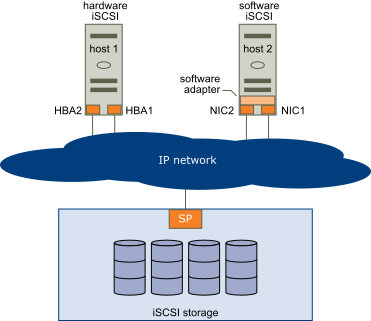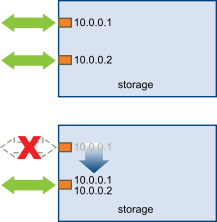To maintain a constant connection between a host and its storage, ESXi supports multipathing. With multipathing, you can use more than one physical path that transfers data between the host and an external storage device.
If a failure of any element in the SAN network, such as an adapter, switch, or cable, occurs, ESXi can switch to another viable physical path. This process of path switching to avoid failed components is known as path failover.
In addition to path failover, multipathing provides load balancing. Load balancing is the process of distributing I/O loads across multiple physical paths. Load balancing reduces or removes potential bottlenecks.
Failover with Fibre Channel
To support multipathing, your host typically has two or more HBAs available. This configuration supplements the SAN multipathing configuration. Generally, the SAN multipathing provides one or more switches in the SAN fabric and one or more storage processors on the storage array device itself.
In the following illustration, multiple physical paths connect each server with the storage device. For example, if HBA1 or the link between HBA1 and the FC switch fails, HBA2 takes over and provides the connection. The process of one HBA taking over for another is called HBA failover.

Similarly, if SP1 fails or the links between SP1 and the switches breaks, SP2 takes over. SP2 provides the connection between the switch and the storage device. This process is called SP failover. VMware ESXi supports both HBA and SP failovers.
Host-Based Failover with iSCSI
When setting up your ESXi host for multipathing and failover, you can use multiple iSCSI HBAs or combine multiple NICs with the software iSCSI adapter.
For information on different types of iSCSI adapters, see iSCSI Initiators.
- ESXi does not support multipathing when you combine an independent hardware adapter with software iSCSI or dependent iSCSI adapters in the same host.
- Multipathing between software and dependent adapters within the same host is supported.
- On different hosts, you can mix both dependent and independent adapters.

- Hardware iSCSI and Failover
-
With hardware iSCSI, the host typically has two or more hardware iSCSI adapters. The host uses the adapters to reach the storage system through one or more switches. Alternatively, the setup might include one adapter and two storage processors, so that the adapter can use different paths to reach the storage system.
On the illustration, Host1 has two hardware iSCSI adapters, HBA1 and HBA2, that provide two physical paths to the storage system. Multipathing plug-ins on your host, whether the VMkernel NMP or any third-party MPPs, have access to the paths by default. The plug-ins can monitor health of each physical path. If, for example, HBA1 or the link between HBA1 and the network fails, the multipathing plug-ins can switch the path over to HBA2.
- Software iSCSI and Failover
-
With software iSCSI, as shown on Host 2 of the illustration, you can use multiple NICs that provide failover and load balancing capabilities for iSCSI connections.
Multipathing plug-ins do not have direct access to physical NICs on your host. As a result, for this setup, you first must connect each physical NIC to a separate VMkernel port. You then associate all VMkernel ports with the software iSCSI initiator using a port binding technique. Each VMkernel port connected to a separate NIC becomes a different path that the iSCSI storage stack and its storage-aware multipathing plug-ins can use.
For information about configuring multipathing for software iSCSI, see Setting Up Network for iSCSI and iSER with ESXi.
Array-Based Failover with iSCSI
Some iSCSI storage systems manage path use of their ports automatically and transparently to ESXi.
When using one of these storage systems, your host does not see multiple ports on the storage and cannot choose the storage port it connects to. These systems have a single virtual port address that your host uses to initially communicate. During this initial communication, the storage system can redirect the host to communicate with another port on the storage system. The iSCSI initiators in the host obey this reconnection request and connect with a different port on the system. The storage system uses this technique to spread the load across available ports.
If the ESXi host loses connection to one of these ports, it automatically attempts to reconnect with the virtual port of the storage system, and should be redirected to an active, usable port. This reconnection and redirection happens quickly and generally does not disrupt running virtual machines. These storage systems can also request that iSCSI initiators reconnect to the system, to change which storage port they are connected to. This allows the most effective use of the multiple ports.
The Port Redirection illustration shows an example of port redirection. The host attempts to connect to the 10.0.0.1 virtual port. The storage system redirects this request to 10.0.0.2. The host connects with 10.0.0.2 and uses this port for I/O communication.

If the port on the storage system that is acting as the virtual port becomes unavailable, the storage system reassigns the address of the virtual port to another port on the system. Port Reassignment shows an example of this type of port reassignment. In this case, the virtual port 10.0.0.1 becomes unavailable and the storage system reassigns the virtual port IP address to a different port. The second port responds to both addresses.

With this form of array-based failover, you can have multiple paths to the storage only if you use multiple ports on the ESXi host. These paths are active-active. For additional information, see Managing iSCSI Session on ESXi Host.
Path Failover and Virtual Machines
When a path fails, storage I/O might pause for 30-60 seconds until your host determines that the link is unavailable and performs the failover. If you attempt to display the host, its storage devices, or its adapters, the operation might appear to stall. Virtual machines with their disks installed on the SAN can appear unresponsive. After the failover, I/O resumes normally and the virtual machines continue to run.
A Windows virtual machine might interrupt the I/O and eventually fail when failovers take too long. To avoid the failure, set the disk timeout value for the Windows virtual machine to at least 60 seconds.
To avoid disruptions during a path failover, increase the standard disk timeout value on a Windows guest operating system.
This procedure explains how to change the timeout value by using the Windows registry.
- Select .
- Type regedit.exe, and click OK.
- In the left-panel hierarchy view, double-click .
- Double-click TimeOutValue.
- Set the value data to 0x3c (hexadecimal) or 60 (decimal) and click OK.
After you make this change, Windows waits at least 60 seconds for delayed disk operations to finish before it generates errors.
- Reboot guest OS for the change to take effect.